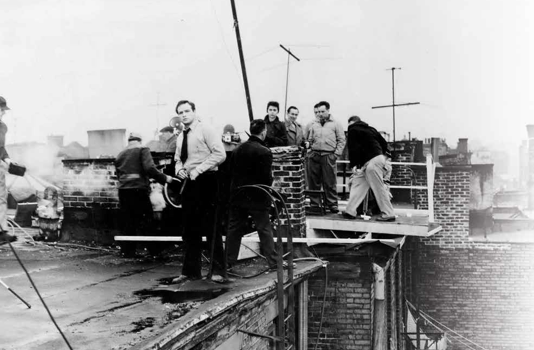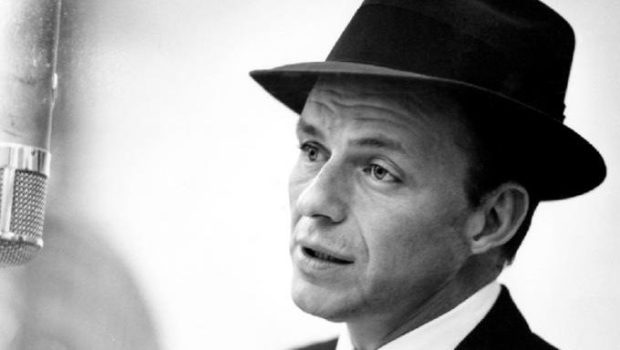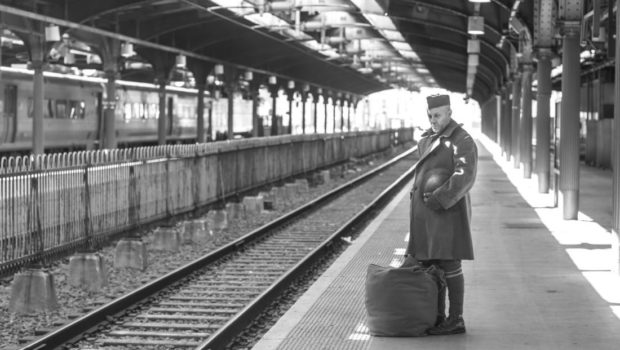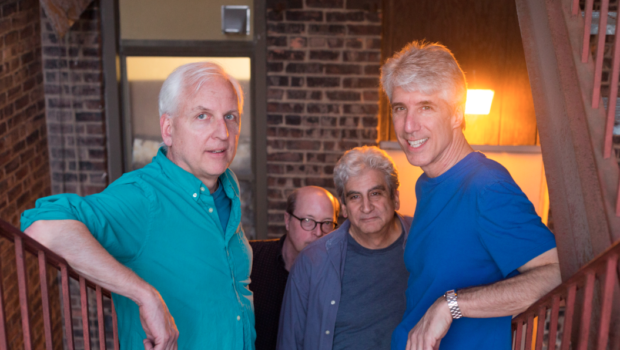
John Stevens, Avid Gardener | Hoboken’s Horticultural History
by Melissa Abernathy
Photos courtesy of the Hoboken Historical Museum
Let’s be honest—Hoboken’s densely built, mostly paved urban landscape is not the first place most people think of when they’re looking for a good garden tour in the Garden State. But in 1998, the Hoboken Historical Museum inaugurated its Secret Garden Tour, inspired by the 200th anniversary of Col. John Stevens’ major contributions to American gardening: The first import to the United States of two of the most popular plants today, the camellia and the chrysanthemum.
Best known as the head of America’s “first family of engineering,” Col. Stevens (1749 – 1838) was equally passionate about gardening, with extensive greenhouses and gardens holding a place of pride adjacent to his grand home, the Villa Stevens (later replaced by Castle Stevens in 1854). His biographer Archibald Turnbull (“John Stevens, An American Record,” 1928) described the Stevens gardens as “the most elaborate and scientifically cultivated of the day,” after those of Dr. David Hosack in New York, with whom the Colonel corresponded and exchanged seeds and plant species. He also compared notes with Thomas Jefferson, well known for his agricultural experimentation at Monticello.
Turnbull says Stevens would order “each book on horticulture as soon as it left the press, while every local sale of seeds or bulbs found him elbowing his way to the front rank of buyers, in case some new variety might be offered.” Further, “every experimental fertilizer had its carefully tended plot at Hoboken, each plant and tree upon the hillside was given its best chance.”
At one point, the irrepressible entrepreneur began a horticultural partnership with Michael Floy, a leading commercial florist of the day, and they commissioned a complete inventory of all plants, shrubs and trees in the Stevens gardens. However, his many engineering projects—railroads, steam-powered boats and an armored Naval battery—not to mention his many business projects (Hoboken Land and Improvement Company, the Bergen Turnpike, Hoboken Ferry Company, to mention a few), prevented him from devoting more time to this initiative.
Nevertheless, Stevens is remembered by horticultural historians for the import in 1798 of the “Single Red” variety of camellia, and the “Dark Purple” variety of chrysanthemum, according to research by Holly Metz, the organizer of the Museum’s first Secret Garden Tour. His interest can be traced to as early as 1765, when he wrote to various growers in Europe and the Caribbean seeking “tender exoticks.” His gardens eventually boasted many vegetables and fruit trees, and hundreds of varieties of flowering shrubs, coffee plants, and exotic plants such as yucca.

On June 7, the Museum is celebrating its 18th annual Hoboken Secret Garden Tour, a tradition that celebrates the urban gardener’s indomitable impulse to cultivate nature and create one’s own private Eden. Up to 10 local gardeners each year open their back yards to guided tours led by Museum volunteers as a fundraiser for the Museum. The variety of styles and plants is as rich today as it was in Col. Stevens’ time. Tickets to the tour are just $25 in advance, $30 on the day of the tour. Visit the Museum’s website, hobokenmuseum.org, for details.
The first Hoboken Secret Garden Tour in 1998 provided tour-goers with detailed plant lists, which had been cross-referenced with Col. Stevens’ seed and plant lists from 1765 – 1801 to indicate which contemporary gardens provided living links to Hoboken’s horticultural history. The original tour offered two routes, one in downtown, one in midtown Hoboken.
Among the gardens in the 1998 tour is one that dedicated fans of the tour will recognize, Bo Dzimon and Adrienne Choma’s garden, which has been transformed dramatically over the years to include simulated gothic arches, a soaking pool and waterfall feature. The couple generously open their lush garden to the Secret Garden Tour on a regular basis. The first tour noted that their roses and butterfly bushes were also favorites of John Stevens.
Modern gardeners will recognize in their own gardens many plants listed in Stevens’ inventories: including rhododendron, azalea, ajuga, daisies, ivy, irises, hypericum, geraniums, clematis, hibiscus, poppies, sunflowers, dianthus, malva, hollyhocks, coreopsis, anemone nemerosa, foxgloves, nasturtium, and gladioli. In his state-of-the-art greenhouses heated with stoves, Stevens grew nasturtium, datura, gardenia, lantana, plumbago, plumeria, and lobelia, among other delicate plants. His vegetable gardens included alpine strawberries, eggplant, grapes (14 varieties in 1801!), beans and 15 lettuces. The Stevens grounds included many types of maple trees, including silver-leaved, striped and “ash-leaved” varieties, plus dogwoods, magnolia, red bud, pomegranate, white birch and black pine trees. And this is just a selective list of the plants that were also found in the 1998 tour gardens.
(MORE ON PAGE 2…)

 Previous Article
Previous Article Next Article
Next Article THE FEAST: St. Ann’s Italian Festival Returns to Hoboken
THE FEAST: St. Ann’s Italian Festival Returns to Hoboken  “On the Waterfront,” Starring… Hoboken!
“On the Waterfront,” Starring… Hoboken!  FRIDAYS ARE FOR FRANK: “From Promise to Promise” (Frank Sinatra & Rod McKuen)
FRIDAYS ARE FOR FRANK: “From Promise to Promise” (Frank Sinatra & Rod McKuen)  FRIDAYS ARE FOR FRANK: “I’ve Got You Under My Skin”
FRIDAYS ARE FOR FRANK: “I’ve Got You Under My Skin”  AN AMERICAN SOLDIER’S JOURNEY HOME: Actor Douglas Taurel Shares the Stories of a World War I Combat Soldier — SUNDAY, NOV. 11th @ Hoboken Historical Museum
AN AMERICAN SOLDIER’S JOURNEY HOME: Actor Douglas Taurel Shares the Stories of a World War I Combat Soldier — SUNDAY, NOV. 11th @ Hoboken Historical Museum  THIS TOWN: Sinatra Biographer James Kaplan Discusses Frank’s Relationship with Hoboken
THIS TOWN: Sinatra Biographer James Kaplan Discusses Frank’s Relationship with Hoboken  A Hoboken Institution, the 110th Annual St. Ann’s Festival Postponed Indefinitely
A Hoboken Institution, the 110th Annual St. Ann’s Festival Postponed Indefinitely  BAR/NONE RECORDS: Three Decades Is The Magic Number
BAR/NONE RECORDS: Three Decades Is The Magic Number